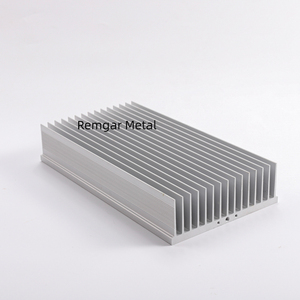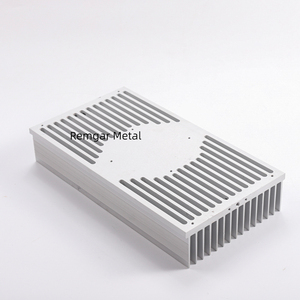(602 products available)




























































































































































































































A 100mm heatsink is a device used to dissipate heat from electronic components. It is 100mm wide and comes in different materials, designs, and configurations, as described below:
By Material
Aluminum: 100mm aluminum heatsinks are lightweight and cost-effective. They are commonly used in consumer electronics and applications where weight and cost are critical factors. Aluminum dissipates heat effectively, making it suitable for a wide range of applications.
Copper: Copper heatsinks are known for their excellent thermal conductivity. They are used in applications where efficient heat dissipation is a priority. However, copper is heavier and more expensive than aluminum. As a result, copper heatsinks are often found in high-performance devices such as CPUs and GPUs.
Metal-composite: Some heatsinks are made from a combination of materials designed to optimize thermal performance and reduce weight. These metal-composite heatsinks offer a balance of thermal conductivity and weight. They are used in specialized applications where both performance and weight are important.
Plastic: 100mm plastic heatsinks are lightweight and resistant to corrosion. They are used in low-power applications or environments where weight and corrosion resistance are more important than thermal performance. While not as effective as metal heatsinks, plastic options can be suitable for specific use cases.
By Design
Passive: Passive heatsinks rely on natural convection to dissipate heat. They are designed with fins or other features that allow air to flow over the heatsink. This flow cools the heatsink and is then suitable for low-power applications or situations where noise is not acceptable.
Active: Active heatsinks include a fan or other cooling device. The fan circulates air over the heatsink and cools it. This method dissipates heat more efficiently than passive designs. Active heatsinks are used in high-power applications where effective heat dissipation is needed. However, they produce noise.
By Configuration
Extruded: Extruded heatsinks are made by forcing metal through a die to create a shape with long, continuous fins. This design increases the surface area and allows more heat to dissipate. Extruded heatsinks are lightweight and suitable for applications where large heatsinks are acceptable.
Forged: Forged heatsinks are made by shaping metal under high pressure and temperature. They have a dense structure and good thermal performance. Forged heatsinks are more robust and suitable for high-performance applications where durability is critical.
Machined: Machined heatsinks are made from solid metal blocks using CNC machines. They have precise dimensions and high thermal performance. Machined heatsinks are more expensive but suitable for applications that need high thermal conductivity and low thermal resistance.
Heatsinks are very important components of electronic devices and systems. They help in cooling and managing the temperature of different devices. The functions of a heatsink include:
The features of a 100mm heatsink include:
There are different applications of a 100mm heatsink. Some of them include the following:
Material:
Aluminum and copper are the two most common heatsink materials. Aluminum is less expensive and lighter, while copper has a higher thermal conductivity. For 100mm sizes, aluminum is typically preferred due to its lower weight and cost compared to larger copper heatsinks. Consider the balance of thermal performance and weight/cost that suits the application.
Fan Requirements:
Some 100mm heatsinks come bundled with fans, while others do not. If a fan is required for adequate cooling, check whether it is included or needs to be purchased separately. Also, review the fan specifications like speed, airflow, and noise level to ensure it meets performance needs.
Mounting Options:
Look at the mounting mechanism of the heatsink. Ensure that the heatsink can be easily mounted on the motherboard without interfering with other components. Consider the socket type and mounting hardware needed for installation.
Thermal Paste:
Some heatsinks come with thermal paste. Thermal paste needs to be applied properly to fill the microscopic gaps between the CPU/GPU and the heatsink for better thermal transfer. Check whether it is included or needs to be applied separately.
Space Constraints:
Consider the physical space available inside the case. A 100mm heatsink may not fit if there are other components close by. Measure the clearance and ensure the heatsink can be installed without obstruction. If space is limited, look for compact or low-profile designs.
Performance Needs:
Higher clock speeds and overclocking require more cooling. If the CPU or GPU will be heavily utilized, choose a 100mm heatsink with good airflow and a powerful fan. Look at the thermal design power (TDP) rating of the processor and select a heatsink that can handle it.
Q1: What is a heatsink 100mm?
A1: A 100mm heatsink is a cooling device with a width and depth of 100 millimeters. This measurement indicates the size of the heatsink, which can also be 100mm in height. The heatsink dissipates heat from electronic components, particularly CPUs and GPUs, generating high temperatures during operation. A 100mm-wide heatsink is ideal for larger chips or components that require substantial cooling to maintain optimal performance and prevent overheating.
Q2: How is heat transferred from a chip to a heatsink?
A2: Heat is transferred from a chip to a heatsink through conduction. Once a chip or electronic component starts operating, it transfers heat to the heatsink via physical contact. The heat is then dissipated into the surrounding environment through convection and radiation. The efficiency of this heat transfer process relies on the thermal conductivity of the materials used and the quality of the interface between the chip and the heatsink.
Q3: What are the factors to consider when choosing a heatsink?
A3: Several factors have to be considered when choosing a heatsink, including the size, material, thermal performance, and airflow. Other factors include the application requirements, ambient temperature, noise level, and budget. The connector compatibility and installation ease also have to be considered. All these factors will ensure that the chosen heatsink meets the specific cooling requirements of the electronic device or component.